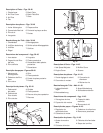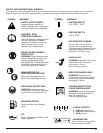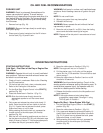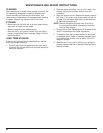
21
• If using a torque wrench and an 5/8 inch socket
tighten to:
37 - 38 Nm
325 - 335 in•lb
27 - 28 ft.•lb
•Without a torque wrench, use a 5/8 inch closed-end or
socket wrench, turning the nut until the blade retainer
is snug against the shaft bushing. Make sure that the
blade is installed correctly, then rotate the nut an
additional 1/4 to 1/2 turn counterclockwise (Fig. 15).
11. Remove the locking rod from the locking rod slot.
12. Remove the blade cover.
REMOVE THE CUTTING BLADE AND
INSTALL THE CUTTING ATTACHMENT
Remove the Cutting Blade
1. Put the blade cover on the cutting blade.
2. Align the shaft bushing hole with the locking rod slot and
insert the locking rod into the bushing hole (Fig. 11).
3. Hold the locking rod in place by grasping it next to
the shaft tube of the unit (Fig. 12).
4. While holding the locking rod, loosen the nut on the
blade by turning it clockwise with a 5/8 inch closed-
end or socket wrench (Fig. 16).
5. Remove the nut, blade retainer, and blade. Store the
nut and blade together for future use in a secure
place. Store out of reach of children.
Install the Cutting Attachment
6. Align the shaft bushing hole with the locking rod slot
and insert the locking rod into the shaft bushing hole.
(Fig. 11). Place the blade retainer on the output shaft
with the flat surface against the output shaft bushing
(Fig. 13). Screw the cutting attachment counter-
clockwise onto the output shaft. Tighten securely.
NOTE: The blade retainer must be installed on the
output shaft in the position shown for the cutting
attachment to work correctly.
7. Remove the locking rod.
8. Install the cutting attachment guard. See Removing
and Installing Cutting Attachment Guard.
ASSEMBLY INSTRUCTIONS
OIL AND FUEL RECOMMENDATIONS
RECOMMENDED OIL TYPE
Using the proper type and weight of oil in the crankcase
is extremely important. Check the oil before each use
and change the oil regularly. Failure to use the correct
oil, or using dirty oil, can cause premature engine wear
and failure.
Use a high-quality SAE 30 weight oil of API (American
Petroleum Institute) service class SF, SG, SH.
ADDING OIL TO CRANKCASE – INITIAL USE
NOTE: This unit is shipped without being filled with oil.
In order to avoid damage to the unit, put oil in
the crankcase before attempting to start unit.
1. Place the unit on a flat level surface.
2. Remove the oil plug / dipstick from the crankcase
(Fig. 17).
3. Pour the 100ml of oil into the oil fill hole (Fig. 18).
NOTE: Never add oil to the fuel or fuel tank.
4. Wipe up any oil that may have spilled and reinstall
the oil fill plug / dipstick.
RECOMMENDED FUEL TYPE
Old fuel is the primary reason for the unit not running
properly. Be sure to use fresh, clean, unleaded petrol.
NOTE: This is a four cycle engine. In order to avoid
damage to the unit, do not mix oil with petrol.
Definition of Blended Fuels
Today's fuels are often a blend of petrol and
oxygenates such as ethanol, methanol or MTBE (ether).
Alcohol-blended fuel absorbs water. As little as 1%
water in the fuel can make fuel and oil separate or form
acids when stored. Use fresh fuel (less than 60 days old),
when using alcohol-blended fuel.
Using Blended Fuels
If you choose to use a blended fuel, or its use is
unavoidable, follow recommended precautions.
• Always use fresh unleaded petrol
• Use the fuel additive STA-BIL
®
or an equivalent.
• Drain tank and run the engine dry before storing unit.
Using Fuel Additives
The use of fuel additives, such as STA-BIL
®
Petrol
Stabilizer or an equivalent, will inhibit corrosion and
minimize the formation of gum deposits. Using a fuel
additive can keep fuel from forming harmful deposits in
the carburetor for up to six (6) months. Add 23 ml (0.8 oz.)
of fuel additive per gallon of fuel according to the
instructions on the container. NEVER add fuel additives
directly to the unit's petrol tank.


















